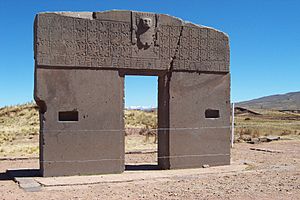Gate of the Sun facts for kids
The Gate of the Sun is a famous stone archway. It was carved from a single, huge stone by the Tiwanaku culture. This ancient civilization lived near Lake Titicaca in Bolivia between about 500 and 950 CE.
The Tiwanaku site is high up in the Andes mountains, about 12,549.2 ft (3,825.0 m) above sea level. The Gate of the Sun is roughly 9.8 ft (3.0 m) tall and 13 ft (4.0 m) wide. It weighs around 10 tons! When Europeans found it in the mid-1800s, it was lying down and had a big crack. Today, it stands where it was found, but experts think this wasn't its first home.
The carvings on the gate are very special. Many believe they show information about the stars, planets, or even a calendar. Some designs might even show cycles of the sky. The Gate of the Sun was built later than other parts of the site. It might have marked a change from worshipping the moon to worshipping the sun.
Contents
Ancient Connections
The art and symbols of the Tiwanaku civilization were very important. Their designs spread across the Andes region. You can see similar images from the Gate of the Sun in other cultures, like the Wari and Inca.
These ancient groups didn't write down their history or beliefs like we do today. However, they used special knotted cords called quipus to record things. We also learned a lot from the Spanish. When they arrived, they wrote down what the Incas told them. The Incas had people who remembered their history through stories. These stories were then written down by Spanish writers, called chroniclers. One famous chronicler was Felipe Guaman Poma de Ayala. He drew over 400 pictures of Inca life and rituals. These drawings help us understand these ancient ways of life.
What is Pseudoarchaeology?
Some early people who studied the Gate of the Sun had strange ideas. For example, Arthur Posnansky and Edmund Kiss thought it showed contact with ancient Nordic people. These ideas are now called pseudoarchaeology. This means they are not based on real scientific methods or facts. Modern archaeologists use better ways to study the past.
Carvings on the Gate
The top part of the gate has 48 squares carved into it. Each square holds a figure with wings. There are 32 figures with human faces. The other 16 figures have the heads of condors. All these figures face a central person.
This central figure's head has 24 rays around it, which some think are sun rays. The figure holds two decorated staffs. These staffs might represent thunder and lightning. Some historians believe this central figure is a "Sun God". Others link it to the Inca god Viracocha.
Another idea is that the figure is Thunupa, or Tunupa. This was a major weather god for the Aymara people in the Titicaca Basin. Thunupa was believed to bring rain, lightning, and thunder. The Tiwanaku people believed their creator gods came from Lake Titicaca. This made the city of Tiwanaku a very important religious place. Worshipping gods connected to the Earth was a big part of Andean religion, especially for the Tiwanaku and Inca. The Inca Sun God was called Inti. He was often shown as a young boy holding gold objects. Experts see similarities between Tiwanaku and Inca art. This shows how much the Tiwanaku culture influenced Inca myths and art.
Old Pictures of the Gate
-
Drawing by Ephraim Squier in 1877. The size is shown bigger than it really is in this picture.
See also
 In Spanish: Puerta del Sol (Tiahuanaco) para niños
In Spanish: Puerta del Sol (Tiahuanaco) para niños





